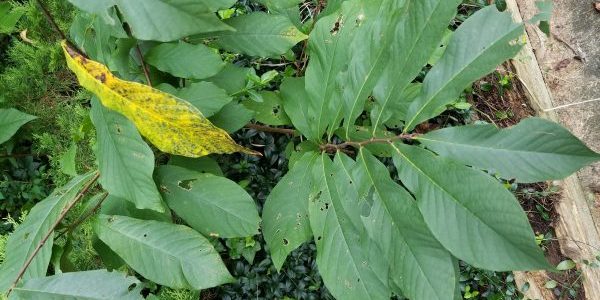The Paw Paw – A Tree So Nice They Named it Twice!
In late summer as we move into fall, many families begin planning fun weekends of apple picking, pumpkin harvesting, fall festivals and more. I have another kids nature activity idea for you to consider – a paw paw safari!
Paw paws? What are they? They are beautiful, medium sized trees that have a somewhat tropical look and delicious, custardy, tropical-tasting fruits. They are native to the Washington DC region and their fruit ripens in our area in mid to late September.
I first learned about paw paws as a teenager when I was hiking in Fairfax County, VA. I stumbled upon some strange looking and fragrant-smelling fruits smashed and partially eaten along the trail. I asked a naturalist friend what these were and discovered that not only were the fruits edible, they were delicious! They tasted like a cross between a banana and a mango.

Paw Paws typically grow where they “have a view.” Most often they are found along creek and river banks and in floodplain type forests. They can also be seen growing along hillsides near streams and rivers.

The Paw Paw is a medium sized tree that is native to the Northern Virginia and Mid-Atlantic region. It has large, oval shaped bright green leaves that turn yellow in autumn. In late summer and early fall, the green skinned fruit ripens and falls to the forest floor.

The sublime zebra swallowtail butterfly are often spotted near paw paw trees because their caterpillars feed only on paw paw leaves. If you are able, plant some paw paws in your yard and not only will get yummy fruit, you will provide habitat for an awesome native butterfly!

The fruit of the paw paw is edible once it has softened – usually when it falls to the ground. Picking hard paw paws off a tree is not a good idea because they won’t ripen unless they are on the tree. I typically search for them on the ground along trails. Be aware that sometimes yellow jackets and hornets will be inside the fallen fruits and also be careful not to gather any fruit that is in poison ivy. You will also want to check with the agency managing the land you are searching to be sure it is OK to gather paw paws. Many parks and natural areas prohibit the removal of any objects, however some parks allow limited gathering of fruit.
When eating a paw paw, you will want to first remove the inedible thin green skin. I use a vegetable peeler or small knife to do this. The soft yellow/orange flesh is studded with large black seeds that also must be avoided. You can either spit them out like watermelon seeds or cut them out and then eat the fruit with a spoon. With young children, I suggest removing the seeds to avoid choking hazards.

Many people use paw paws to make jams, jellies, ice creams, sweet breads and other delights. Paw paws are also occasionally seen for sale at farmers markets in the DC area but are not yet considered a commercial crop because of the difficulty in shipping and handling these delicate fruits.
This fall, add a paw paw safari to your family weekend activities! Kids and grown ups alike will have a naturally good time.
Want to bring a naturally fun nature program to your school or family event? Check out all the different wildlife puppet shows I offer that are perfect for kids who love nature.







